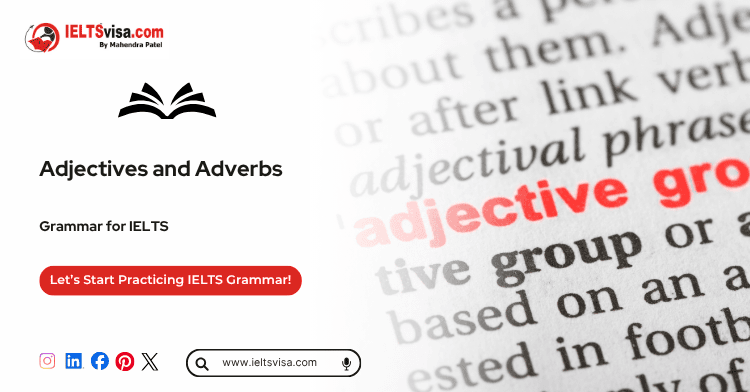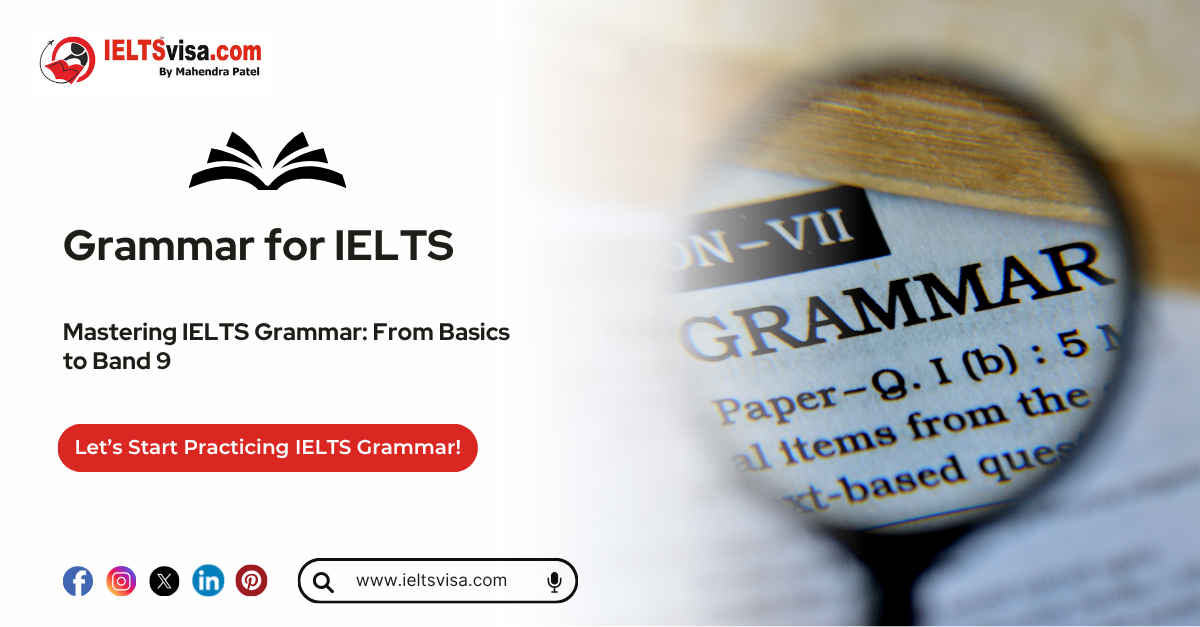Adjectives and Adverbs
Grammar for IELTS

Adjectives and Adverbs
Adjectives and adverbs play an essential role in English grammar, enriching our sentences with detail and precision. Understanding how to use these parts of speech correctly can help beginners and advanced learners alike improve their writing and speaking skills. This guide explores the definitions, types, rules, and usage of adjectives and adverbs, complete with examples and practical tips for mastering them.
Table of Contents
1. What Are Adjectives?
-
- Definition
- Importance of Adjectives
2. Types of Adjectives
-
- Descriptive Adjectives
- Quantitative Adjectives
- Demonstrative Adjectives
- Possessive Adjectives
- Interrogative Adjectives
- Proper Adjectives
- Compound Adjectives
3. Rules for Using Adjectives
4. What Are Adverbs?
-
- Definition
- Importance of Adverbs
5. Types of Adverbs
-
- Adverbs of Manner
- Adverbs of Time
- Adverbs of Place
- Adverbs of Frequency
- Adverbs of Degree
6. Rules for Using Adverbs
7. Key Differences Between Adjectives and Adverbs
8. Common Mistakes and How to Avoid Them
9. Adjective and Adverb Placement in Sentences
10. Comparative and Superlative Forms
-
- Rules for Forming Comparatives and Superlatives
- Examples
11. Examples of Adjectives and Adverbs in Sentences
12. Practice Exercises
13. FAQs on Adjectives and Adverbs
14. Tips for Mastery
1. What Are Adjectives?
Definition
Adjectives are words that describe or modify nouns and pronouns. They provide more information about the qualities, quantities, or states of the nouns they accompany.
Importance of Adjectives
-
-
- Add depth and detail to writing.
- Help paint vivid pictures in the reader’s mind.
- Enhance communication by making descriptions more specific.
-
2. Types of Adjectives
Descriptive Adjectives
-
- Describe the quality, size, shape, color, or condition of a noun.
- Examples: beautiful, tall, round, blue, happy.
Quantitative Adjectives
-
- Indicate the quantity of a noun.
- Examples: few, many, much, several, all.
Demonstrative Adjectives
-
- Point to specific nouns.
- Examples: this, that, these, those.
Possessive Adjectives
-
- Indicate ownership.
- Examples: my, your, his, her, its, our, their.
Interrogative Adjectives
-
- Used to ask questions about a noun.
- Examples: which, what, whose.
Proper Adjectives
-
- Derived from proper nouns.
- Examples: American (from the United States), Shakespearean (from William Shakespeare).
Compound Adjectives
-
- Made up of two or more words, often connected with a hyphen.
- Examples: well-known, high-quality, ice-cold.
3. Rules for Using Adjectives
1. Adjectives come before the noun they modify.
-
- Example: A red balloon floated away.
2. Adjectives can also follow a linking verb.
-
- Example: The sky is blue.
3. Multiple adjectives are ordered in a specific sequence:
-
- Quantity, Opinion, Size, Age, Shape, Color, Origin, Material, Purpose.
- Example: Three small old wooden chairs.
4. What Are Adverbs?
Definition
Adverbs are words that modify verbs, adjectives, or other adverbs. They describe how, when, where, or to what extent an action is performed.
Importance of Adverbs
-
- Add clarity to actions and descriptions.
- Provide additional information about the intensity, frequency, or manner of an action.
5. Types of Adverbs
Adverbs of Manner
-
- Describe how an action is performed.
- Examples: quickly, slowly, carefully, loudly.
Adverbs of Time
-
- Indicate when an action occurs.
- Examples: today, tomorrow, yesterday, soon.
Adverbs of Place
-
- Indicate where an action occurs.
- Examples: here, there, everywhere, outside.
Adverbs of Frequency
-
- Indicate how often an action occurs.
- Examples: always, often, sometimes, rarely.
Adverbs of Degree
-
- Indicate the intensity or degree of an action or quality.
- Examples: very, too, quite, almost, extremely.
6. Rules for Using Adverbs
1. Adverbs often end in “-ly,” but not always.
-
- Examples: happily, quickly (but also fast, well, hard).
2. Adverbs of manner usually follow the verb or object.
-
- Example: She sings beautifully.
3. Adverbs of frequency come before the main verb but after auxiliary verbs.
-
- Example: I always go to bed early.
7. Key Differences Between Adjectives and Adverbs
|
Aspect |
Adjectives |
Adverbs |
|
Modifies |
Nouns and pronouns |
Verbs, adjectives, or other adverbs |
|
Examples |
The quick fox. |
The fox runs quickly. |
|
Position |
Before a noun or after a linking verb |
Varies (often after a verb) |
8. Common Mistakes and How to Avoid Them
1. Using an adjective instead of an adverb:
-
- Incorrect: He ran quick.
- Correct: He ran quickly.
2. Misplacing adverbs in a sentence:
-
- Incorrect: She only eats chocolate.
- Correct: She eats only chocolate.
9. Adjective and Adverb Placement in Sentences
1. Adjective placement:
-
- Before the noun: A happy child.
- After the verb: The child is happy.
2. Adverb placement:
-
- Manner: She writes beautifully.
- Frequency: He rarely skips breakfast.
- Time: They arrived late.
- Place: The book is here.
10. Comparative and Superlative Forms
Rules for Forming Comparatives and Superlatives
1. One-syllable adjectives/adverbs:
-
- Add “-er” for comparatives and “-est” for superlatives.
- Examples: tall → taller → tallest.
2. Two-syllable words:
-
- Use “more” for comparatives and “most” for superlatives.
- Examples: careful → more careful → most careful.
3. Irregular forms:
-
- Examples: good → better → best; well → better → best.
11. Examples of Adjectives and Adverbs in Sentences
1. Adjectives:
-
- The small kitten was adorable.
- She wore a beautiful dress.
2. Adverbs:
-
- He spoke softly to the baby.
- They will arrive soon.
12. Practice Exercises
1. Fill in the blanks with the correct adjective or adverb:
-
- She drives ________ (careful/carefully) on icy roads.
- It was a ________ (sunny/sunnily) day.
2. Identify the adjectives and adverbs in the following sentences:
-
- The dog barked loudly at the intruder.
- The red car sped past quickly.
Answers:
- carefully, sunny.
- Adjectives: red; Adverbs: loudly, quickly.
Tips for Mastery
1. Read regularly: Observe adjective and adverb usage in books and articles.
2. Practice writing: Use varied adjectives and adverbs in your sentences.
3. Review comparative and superlative rules: This will improve your descriptive skills.
FAQs on Adjectives and Adverbs
Q1. Can an adjective modify a verb?
No, adjectives modify nouns or pronouns. Adverbs modify verbs.
Q2. Do all adverbs end in “-ly”?
No, some adverbs do not end in “-ly,” such as fast, well, and hard.
Q3. What’s the difference between “good” and “well”?
“Good” is an adjective, while “well” is usually an adverb.

Our Books
Master IELTS Speaking Part 1
IELTS Writing Task 1 Book
IELTS Writing Task 2 Book
Practice IELTS Other Modules
IELTS Listening
The IELTS Listening test assesses how well you can understand spoken English in various contexts. It lasts about 30 minutes and is divided into four sections with a total of 40 questions. The listening tasks become increasingly difficult as the test progresses.
IELTS Academic Reading
The IELTS Academic Reading section assesses your ability to understand and interpret a variety of texts in academic settings. It is designed to evaluate a range of reading skills, including skimming for gist, reading for main ideas, reading for detail, understanding inferences, and recognizing a writer's opinions and arguments.
IELTS Speaking
The IELTS Speaking test assesses your ability to communicate in English on everyday topics. It lasts 11-14 minutes and consists of three parts: introduction, cue card, and a discussion based on the cue card topic.
IELTS General Reading
IELTS General Reading tests your ability to understand and interpret various types of texts. Here are some key areas and types of content you can expect to encounter in the reading section, along with tips for effective preparation.
IELTS Academic Writing Task 1
In IELTS Academic Writing Task 1, you are presented with a visual representation of information, such as graphs, charts, tables, or diagrams, and you are required to summarize, compare, or explain the data in your own words.
IELTS General Writing Task 1
In IELTS General Writing Task 1, you are required to write a letter based on a given situation. The letter can be formal, semi-formal, or informal, depending on the prompt. Here’s a breakdown of the key components to include in your letter
IELTS Academic Writing Task 2
In IELTS Academic Writing Task 2, you are required to write an essay in response to a question or topic. Here’s a guide to help you understand the essential elements of this task
IELTS Exam Tips
To succeed in the IELTS exam, practice regularly, familiarize yourself with the test format, improve your vocabulary, develop time management skills, and take mock tests to build confidence.
Grammer for IELTS
Grammar is the foundation of effective communication in English. Understanding tense usage, subject-verb agreement, and sentence structure enhances clarity and coherence in writing and speaking.
Vocabulary for IELTS
Vocabulary plays a crucial role in the IELTS (International English Language Testing System) exam, especially in the Speaking and Writing sections. Here’s an overview of why vocabulary is important and how it impacts your performance
RECENT IELTS SAMPLES QUESTIONS AND ANSWERS
IELTS Speaking Part 1 – Favourite Sujbect – Physics
IELTS Speaking Part 1 - Favourite Sujbect - Physics Q: What is your favourite subject? A: My favourite subject...
IELTS Speaking Part 1 – Present Situation (Student)
IELTS Speaking Part 1 - Present Situation (Student) Q1: Are you a student or do you work?A: I’m a full-time...
IELTS Speaking Part 1 – Present Situation – Employee – as an International Student and Social Worker
IELTS Speaking Part 1 - Present Situation - Employee - as an International Student and Social Worker Q1: Are...
IELTS Speaking Part 1 – Persent Situation – Employee- as an Electric Engineer
IELTS Speaking Part 1 - Persent Situation - Employee- as an Electric Engineer Q1: What do you do for a...
IELTS Speaking Part 1 – Persent Situation – Employee – as an Software Engineer
IELTS Speaking Part 1 - Persent Situation - Employee - as an Software Engineer Q1: What do you do for a...
IELTS Speaking Part 1 – Persent Situation – Married
IELTS Speaking Part 1 - Persent Situation - Married Q1: Are you married?A: Yes, I am married. My spouse and I...













